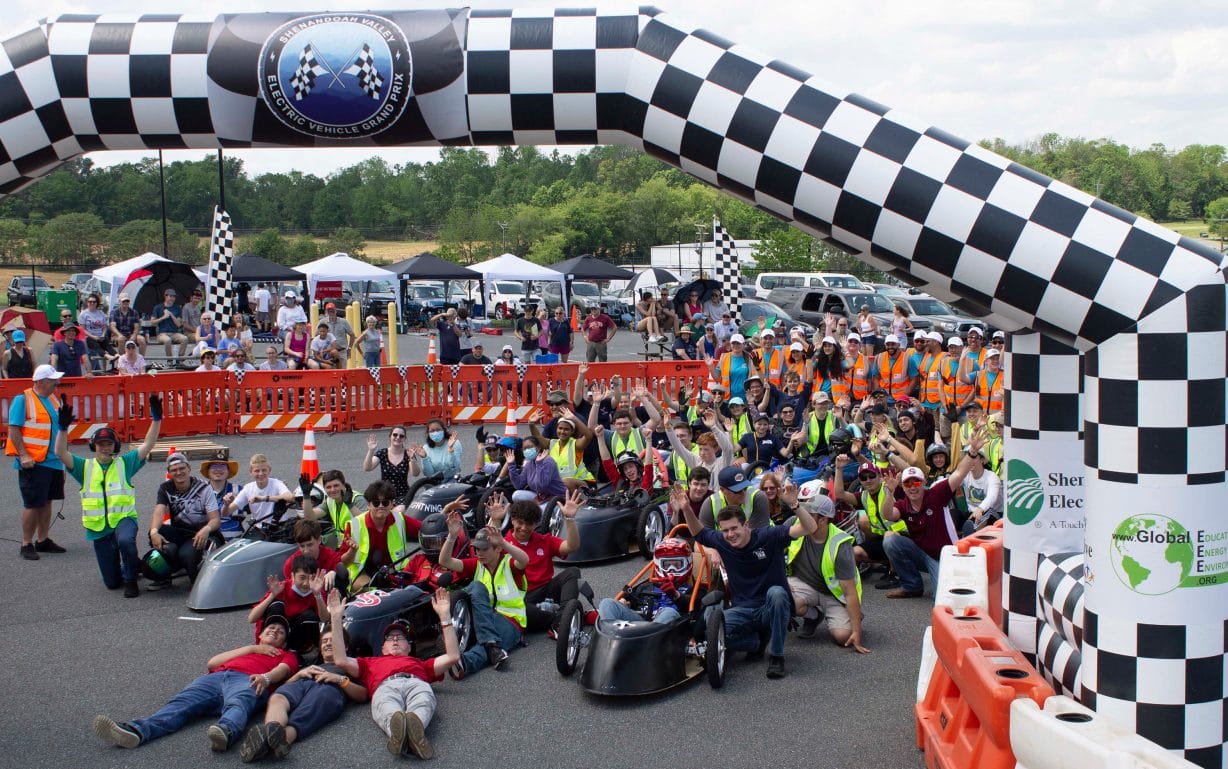
Photos, video and article by Zia Faqiri, contributor
For generations, kids have been building soapbox cars and racing them in derbies, but the days of actual soapboxes on lawnmower wheels have given way to vehicles that are far more complicated and powerful while being eco-friendly.
Eleven high schools in the Shenandoah Valley competed against each other using the electric cars they had been building since January.
The race took place Saturday at the Shenandoah Valley Electric Cooperative, which provides electricity to areas surrounding Harrisonburg, although not Harrisonburg, itself. This Electric Vehicle Grand Prix has been taking place in Washington, D.C., for the past 15 years and this was the first time this event was brought to the Valley.
Sponsors, including the Shenandoah Valley Electric Coop and Old Dominion Electric Co-op, helped cover half the cost of the electric vehicle kits for the schools to keep the cost of entry lower for them, said Kendall Earhart, one of the public relations representatives for the Shenandoah Valley Electric Co-op.
“We wanted as many schools to be able to compete as we could so the first 10 teams that were entered, we covered half their car,” Earhart said.
The event was split into two separate races, each 30 minutes with a break in-between, where drivers would have to make as many laps as they could. Teams weren’t allowed to charge their cars during the break, so they were also keeping an eye on their battery to make sure it didn’t run out.
“You always have to be on your heels,” said Broadway High School pit crew member Ryan Sprague. “If something goes wrong with the car, you have to be ready to figure out what that problem is and make sure that you get it fixed in a timely manner so your drivers can get back into the race.”
Stuarts Draft High School won after the team completed 60 laps. Both Millbrook High School and James Wood High School ended their races with 57 laps, but Millbrook finished third because their team finished 50 seconds slower than James Wood. In addition to bragging rights, the winning teams walked away with trophies.
“I plan on doing this in the future years, I’m very excited about it. This is a really cool project I got to do,” Sprague said. “I get to do a fun thing with my friends and I look forward to being able to continue working on this car through the challenges.”
As Greg Rogers, the electric cooperative’s president and CEO, said, the derby has come a long way since he was in school 40 years ago.
“Back then, in that day, you took old plywood and your dad’s old lawnmower wheels, and you nailed it on, and you found a good hill and you went down,” Rogers said. “These cars, it’s just amazing to me the technology and the expertise that it takes these kids to put them all together and make them run.”
Earhart said one of the things organizers were worried about was the possibility of rain stopping the race. Ultimately, they had a different weather element to deal with — a sweltering heat that kept the thermometer around 89 degrees Fahrenheit the whole day.
“It’s pretty hot out there with a jacket on and a helmet and gloves and all that and you don’t have a ton of wind flow because the body does a pretty good job of getting the air around you instead of on you,” said Broadway High School’s driver, Adam Conley. “I did, I think, 15 laps or something like that, and it was pretty toasty.”
At one point, one of the emergency workers for SVEC drove onto the track to fix an outage that had occurred.
“We just had an outage and one of our line guys came in to get material to go repair the outage. So, reliability all the time, can’t stop the co-ops work just because we have an event,” Earhart said. “You can have a power outage any time.”
The interruption pushed the race back by 10 minutes, after that, the event went on without a hitch. There was an award ceremony after the races where students mingled as the results were announced.
While Saturday marked the first event of its kind in the Valley, organizers said they hope the event only grows from here.
“Going forward, we’d actually love to get some more partners, we’d like to have some of these tents filled up with other sponsors and people that are interested in not only preparing future leaders for our communities, but also for just helping support youth organizations,” Earhart said.
Journalism is changing, and that’s why The Citizen is here. We’re independent. We’re local. We pay our contributors, and the money you give goes directly to the reporting. No overhead. No printing costs. Just facts, stories and context. We’re also a proud member of the Virginia Press Association. Thanks for your support.

